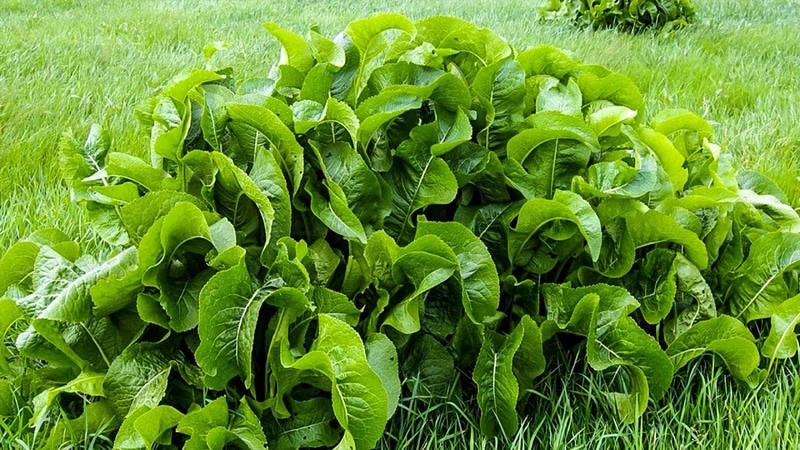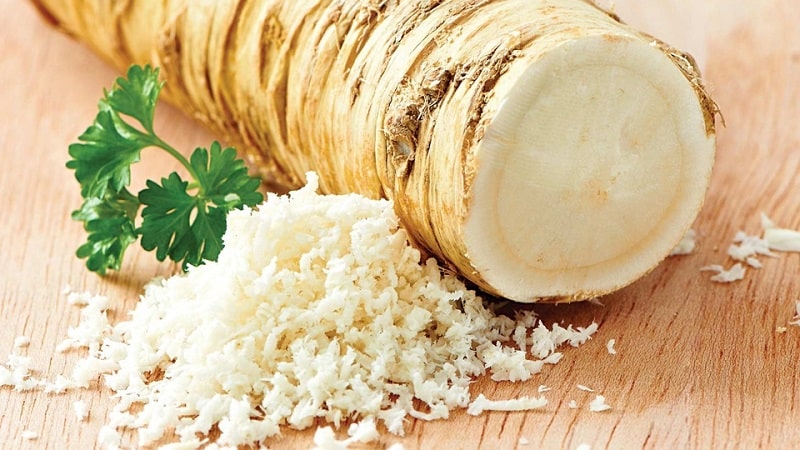All about horseradish: what it is, what it looks like and blooms, what the root is
Country horseradish, or ordinary horseradish, is a type of plant known since ancient times in our country. It is distributed almost throughout the globe, although it came to America and Asia only in the 20th century. The plant has an amazing morphology, is picky about growing conditions, and many consider it the worst garden weed. Read all about horseradish in this article.
Horseradish: what is it

Horseradish, or rustic (Armoracia rusticana), is a perennial herbaceous spicy-aromatic rhizome plant of the cruciferous (cabbage) family. It is found in the wild throughout Europe, Siberia, and the North Caucasus. The culture has also adapted perfectly to the conditions of North America, where it was brought relatively recently.
The plant prefers well-moistened soil, so it inhabits lowlands, banks of reservoirs and shady areas of forest. If its spread is not limited in the garden, it will occupy a large area in one season. It is very difficult to fight it as a weed, because the root system goes 2-5 m into the ground, and a new root or shoot can form from each bud on the rhizome.
Horseradish became a garden resident in our country back in the 6th century. Now it’s hard to imagine a summer cottage or a household plot without it. In cooking it is used as a spicy seasoning and to add flavor to preparations. In the first case, the rhizome is used, in the second - the leaves.
What does horseradish look like?
In the first year, the plant forms a rosette of 6-10 large green leaves on hard and long petioles. The leaf is entire, the edge is crenate. In the second year it produces a peduncle in the form of an erect branched stem from 0.5 to 1.5 m long.
The buds bloom in early June. Flowering lasts 30-40 days. By mid-July the process is completed. The flowers are small, white, fragrant, collected in a brush. One flower lives from two to five days, blooming every morning and closing in the evening. The fruit is a pod.
Horseradish in the photo.

Horseradish root
This is the most valuable part of the plant in cooking. The root is taproot, fleshy and thick, up to 10 cm in diameter, with well-developed appendages. Along the entire length of the root, dormant buds are arranged in a spiral shape, from which rosettes of leaves or new roots are formed.
Important! If you divide the rhizome into several parts and leave them in the soil, each can form a new plant.
The roots are covered with hard, light yellow bark. The radius of the rhizome is up to 0.6 m, the depth is 0.3 m. The main rod can overcome a depth of 5 m.
Seeds

The plant produces fruits in the second year of life. By mid-August, 1-2 cm long pods containing four seeds each form in place of the inflorescences. They are very small, dark red or brown in color. Germination is poor - out of ten seeds only 2-3 germinate.
Important! Garden forms of horseradish, as a rule, do not set seeds. Reproduction occurs by vegetative means.
Horseradish is a herb, vegetable, or root vegetable.
From a botanical point of view, horseradish is a perennial herb; from a culinary point of view, it is a spicy vegetable. But it is incorrect to call the underground part of a plant a root crop, although such a definition is often found in everyday life. The type of horseradish root is rhizome.
Features of the plant

Horseradish grows in one place for up to five years. However, over this period of time, its rhizome becomes lignified, coarsens and dries out, therefore, from a culinary point of view, it becomes unsuitable for consumption.
After 2-3 years of growing horseradish replanted or weeded out, allowing young shoots to grow. In mass production, it is cultivated in one area for no more than 1-2 years.
Important! The stem of some plants reaches 1.5 m in height. Growth and number of leaves depend on the feeding area, agricultural technology and age.
Horseradish is a cross-pollinated plant. Pollen is carried from flower to flower by insects.
Country horseradish is a frost-resistant plant and tolerates winter well with temperatures down to -25°C in open ground and up to -8...-10°C after the leaves grow in the spring. However, it cannot tolerate heat at all and can die even at +30°C, although it chooses well-lit areas with a sufficient level of moisture in the ground.
Horseradish is demanding on soil and air moisture levels. This is due to its morphology. During the growing season, the plant grows a large green mass, from the surface of which water intensively evaporates, and the deeply penetrating root system has weak absorption in the upper layers of the soil.
Despite the high content of essential oils and spicy aroma, horseradish is highly susceptible to attacks by insect pests. It has no less diseases than tomatoes. Under favorable conditions, the plant is very resistant to diseases and pests.
Read also:
How to prepare cabbage with horseradish: recipes from experienced housewives
Recipes for preparing the most delicious cucumbers without vinegar for the winter
How and when does horseradish bloom?
In the second year of life, the plants begin to grow as soon as the snow melts. Peduncles begin to emerge at the end of April - beginning of May in the middle zone. In Siberia and the Urals - two weeks later. By the beginning of flowering, the main stem grows to 1.0-1.3 m, the mass of leaves is about 2.5-3 kg. The flowers are bisexual, white, regular, grow in multi-flowered racemes, collected in paniculate inflorescences. Most cultivated varieties of horseradish have sterile flowers.
The flowers at the bottom of the stem begin to open in early summer. This process continues until the end of the first ten days of July. Tea made from horseradish buds has a specific taste, while being very refreshing and thirst-quenching.
Important! During the period of intense flowering, horseradish forms beautiful white fluffy clusters.
The picture shows horseradish blossoming.

Conclusion
Horseradish is an amazing plant. It is difficult to remove him from the site if he has taken up residence on his own. At the same time, for some owners, all attempts to grow it end in failure. It is demanding on soils, summer temperatures and humidity. But it tolerates winter frosts and spring return frosts well.
The above-ground part of horseradish can grow to a height of 1.5 m, and the rhizome penetrates into the deep layers of the soil up to 5 m. This plant blooms for a long time and beautifully, and the aroma of the blossoming buds does not have a specific spicy hue characteristic of leaves and roots. In cooking, horseradish is used entirely: the root is used as a spicy seasoning, the leaves are used for marinades, and the flowers are used to make tea.